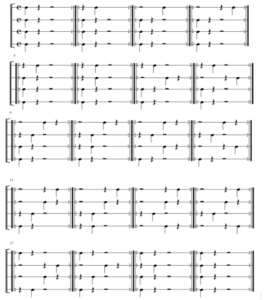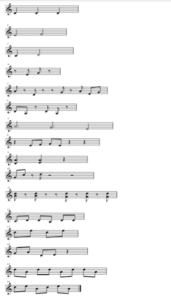Minimal Music Teaching in Practice

Through practical lessons, teachers can introduce their students directly to every aspect of Minimal Music. It is precisely through playing minimalist pieces, improvising and composing that pupils will experience the principles of Minimal Music and be able to understand its significance. The enormous inclusive potential should be emphasised here once again. Unlike in classical music, pupils with different musical levels can participate. This is made possible, for example, by the percussive instruments, the very gradual introduction to musical patterns and playing together without hierarchies. Teachers, even if they know minimalist music, usually do not have the materials to work on this music with pupils. The current standardised teaching materials contain hardly any suitable playing material.
- The Nutshell
- Activities
- Resources
What has been worked out so far can enormously enrich music lessons in different ways – even beyond a purely historical view in the context of an encounter with the music of the 20th century. Firstly, the value of simplicity or reduction can be realised in a pedagogically extremely productive way within the framework of creative processes. This applies to both improvisational and compositional approaches. Reduced musical material, whether in terms of tone, rhythm or chord material, enables musical creativity, especially where an almost endless reservoir of musical material from the cultures of the world as well as popular and Western music usually simply overwhelms or blocks pupils. In addition, the idea of the musical process, which is based on both repetition and gradual development, ensures an elementary, model-free form.
Other opportunities in the context of musical practice include the use of all kinds of instruments, the learning of fundamental rhythmic structures and a new musical experience beyond the eternal poles of so-called serious and popular music. At the same time, creative principles of music from other cultures are learnt and a special feature of art history, the parallel of various minimalist artistic approaches, is experienced. All these advantages speak in favour of learning about and practising Minimal Music outside of school institutions: in music schools, in certain social groups, with older and younger people, in a wide variety of communities.
The next step is therefore to teach practical lessons such as the following:
- Playing the simplest minimalist (workshop) pieces
- Playing simple original works
- Inventing minimalist processes
- Composing minimalist music
- Improvising minimalist processes
- Practising minimalist movement games
There is not an activity for each of these suggestions. Nevertheless, samples of how they can be taught are presented.
Activities
- Get to know these four examples of simple Minimal Music and games by Ulli Götte
Ulli Götte: Rhythmic Game
This four-part piece is to be understood as a performance piece, but also as an example of minimalist composition. Initially, the sounds are freely selectable, with each voice using only a single sound. This can be a tone, a chord, a syllable of speech, an everyday sound or an electronically generated sound. Each bar is played a total of four times before switching to the next. Reduction and processuality are immediately recognizable here as strategies of Minimal Music.

Terry Riley / Ulli Götte: In D
In C requires a performance by professional musicians, but can also be mastered by good instrumentalists. In order to shorten the long rehearsal time and to be able to include less good instrumentalists, Götte has developed In D, which however contains the identical performance instructions as In C. In D requires a quarter pulse as a common basis, played on a high d. By omitting more complex patterns, the level or demand can be reduced.

Ulli Götte: Resting Game
each person chooses three sounds (instrument or everyday sound) and has the task (preferably with eyes closed) of distributing these three sounds over a longer period of time (without a common beat)
Ulli Götte: Moving Game
Minimalist-repetitive structures can be translated directly from music into movement. The following example shows such a transfer: First, three groups are formed A, B and C, with all participants standing next to each other in a row. Group A moves three steps forward and three steps back, B does this with the number 4, C with the number 5. All steps take place in a common pulse, all steps should have the same length. You start at the same time and end the game exactly when all groups are back in the same starting position.
Develop your own simple Minimal Music pieces according to the principles you have learned from Ulli Götte’s examples (Activity 1), depending on the level of the students to be taught, and rehearse them with them: E.g. create your own version in E modeled on Riley’s In C and with the help of Götte’s In D
Steve Reich: Clapping Music
Two players or two groups clap in unison, the basic pattern derived from West African music, until one of them shifts the pattern by the value of an eighth note and thus starts the phase-shifting process. The 2nd bar, however, does not quite correspond to the original version (according to which one proceeds immediately from the 1st to the 3rd bar), but experience has shown that it helps with the transition and thus with the process of ‘overtaking’. The piece ends when the unison situation is re-established.
Steve Reich: Music for Pieces of Wood
This piece is realized by 5 players, but can also be played by 5 groups. As the chromatic scale is not always available, the following pitch assignment is recommended: Clave 1 – b” / Clave 2 – g” / Clave 3 – f” / Clave 4 – a” / Clave 5 – b’. Even if Reich allows certain tolerances in the original with regard to the repetition, it seems sensible to fix the number of repetitions. The music example contains the complete 2nd part.
Literature by Ulli Götte
– Minimal Music – Musikalisches Schlafmittel oder Weg zum bewußten Hören?
in: Musik und Bildung, 6/1993
– Der weltweite Reiz der Einfachheit; in: Musik und Unterricht 77/2004
– Schön einfach – einfach schön; in: klasse musik 1/2005
– Mythos Glass; in: Neue Zeitschrift für Musik, 2/2007
– Minimal Music. Apekte einer sperrig-nichtsperrigen Musikästhetik, in: Fr. Heß und J. Terhag (Hr.), Musikunterricht heute 7, Oldershausen 2008
